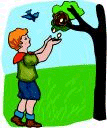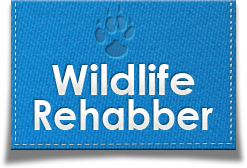How to renest wild nestling baby birds
 |
After you have completed the health and age screening steps from Steps 1 and 2, it’s time to put this nestling baby back. A little work will help ensure success in reuniting a nestling with its parents. If at any point you determine that the baby is not 100% healthy, or if other commitments prevent you from devoting enough time to thoroughly complete each step below please go directly to Emergency Care for information on safely confining this baby until you can locate a rehabilitator and transport the baby. |
You will need to:
- know where to renest
- know whether to return to original nest or create a substitute nest
- observe to ensure it is a success
1.
Look for possible nest locations 
A nestling rarely travels very far from the spot where it originally fell. The nest will usually be within 20-30 feet. 2.
Watch for parent birds carrying food 
If only one bird fell, then its siblings are probably still in the original nest. Watch the trees that you suspect the baby originated. You should be able to observe a parent bird returning to the tree every 20-40 minutes with food. 3.
Attempt to locate nest 
Nests are located in different locations and heights on a tree depending on the species of bird. 4a.
Return to original nest 
If it appears that there are too many babies in the nest or the nest appears damaged, it may be necessary to construct a substitute nest that all the growing babies can fit in. or
4b.
Create substitute nest near original site 
 An ideal substitute nest will be 8-10 inches in diameter, at least 6 inches deep and have drainage holes. Plastic hanging baskets are ideal for this purpose. Line it to the top with dry grasses or straw, then press down the center of the lining with your fist to make a small bowl-like depression to hold the baby.
An ideal substitute nest will be 8-10 inches in diameter, at least 6 inches deep and have drainage holes. Plastic hanging baskets are ideal for this purpose. Line it to the top with dry grasses or straw, then press down the center of the lining with your fist to make a small bowl-like depression to hold the baby.5.
Properly position nest 
Where the substitute nest should be hung in the tree: - Away from the trunk (otherwise it may be accessible to cats).
- 6-8 feet off the ground (so it can’t be disturbed by activity below it.
- Underneath overhead branches and leaves (for protection from sunlight, rain, overhead predators).
- In a tree not more than 20 feet away from where baby was originally found (Parent birds won’t search a neighborhood for their baby. They recognize their baby by voice and will only return to the original location to look for it).

6.
Observe from distance to ensure parents return with food 
Remember to: - Keep out of sight and minimize all activity otherwise the parents will not feel safe enough to return.
- Keep pets and children away from the area.
- Don’t wait for the parents for more than 2 hours. If the parents have not begun actively caring for the baby after 2 hours, CLICK HERE.




